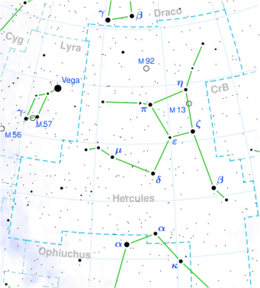Omicron Herculis
Topic: Astronomy
 From HandWiki - Reading time: 4 min
From HandWiki - Reading time: 4 min
| Observation data Equinox J2000.0]] (ICRS) | |
|---|---|
| Constellation | Hercules |
| Right ascension | 18h 07m 32.55073s[1] |
| Declination | +28° 45′ 44.9679″[1] |
| Apparent magnitude (V) | 3.83[2] |
| Characteristics | |
| Spectral type | B9.5III[3] |
| U−B color index | −0.07[2] |
| B−V color index | −0.02[2] |
| Variable type | γ Cas[4] |
| Astrometry | |
| Radial velocity (Rv) | −29.5[5] km/s |
| Proper motion (μ) | RA: −0.02[1] mas/yr Dec.: +8.55[1] mas/yr |
| Parallax (π) | 9.65 ± 0.16[1] mas |
| Distance | 338 ± 6 ly (104 ± 2 pc) |
| Absolute magnitude (MV) | −1.24[6] |
| Details | |
| Mass | 3.49±0.04[7] M☉ |
| Radius | 6.3[8] R☉ |
| Luminosity | 355 L☉ |
| Surface gravity (log g) | 2.86[9] cgs |
| Temperature | 9,484[8] K |
| Metallicity [Fe/H] | −0.06[6] dex |
| Rotational velocity (v sin i) | 194[10] km/s |
| Other designations | |
| Database references | |
| SIMBAD | data |
Omicron Herculis, Latinized from o Herculis, is a star in the constellation Hercules. It used to be called Masym ("the wrist"), but this name was transferred to Lambda Herculis.[11]
Properties
Omicron Herculis is a B9.5III star approximately 106 pc from the Earth. It has an apparent magnitude of 3.83. The star radiates with a bluish-white hue, and has a luminosity approximately 355 times as bright as the Sun. Omicron Herculis is 3.49 solar masses.[7] Stellar evolutionary caclulations show that it has just left the main sequence.[7]
Omicron Herculis is an eruptive variable of the Gamma Cassiopeiae class,[4] which are rapidly rotating B-class stars with mass outflow. It has a projected rotational velocity of 194 km/s.[10]
Some sources list Omicron Herculis as being both spectroscopic and an interferometric binary star with a separation of about 60 milliarcseconds, although the companion star has not been confirmed.[12]
Omicron Hercules is notable for residing close to the coordinates of the solar apex, the direction towards which the Sun is moving. This was first noticed by William Herschel in 1783,[13] although in his first calculation he identified this point with Lambda Herculis.[14] It will eventually become the brightest star in the night sky in approximately 3.47 million years from today, at –0.63,[15] slightly less bright than Canopus today.[15]
References
- ↑ 1.0 1.1 1.2 1.3 1.4 van Leeuwen, F. (November 2007), "Validation of the new Hipparcos reduction", Astronomy and Astrophysics 474 (2): 653–664, doi:10.1051/0004-6361:20078357, Bibcode: 2007A&A...474..653V.
- ↑ 2.0 2.1 2.2 Johnson, H. L. et al. (1966), "UBVRIJKL photometry of the bright stars", Communications of the Lunar and Planetary Laboratory 4 (99): 99, Bibcode: 1966CoLPL...4...99J.
- ↑ Slettebak, A. (1982), "Spectral types and rotational velocities of the brighter Be stars and A-F type shell stars", Astrophysical Journal Supplement Series 50: 55, doi:10.1086/190820, Bibcode: 1982ApJS...50...55S.
- ↑ 4.0 4.1 Samus, N. N. et al. (2017), "General Catalogue of Variable Stars", Astronomy Reports, GCVS 5.1 61 (1): 80–88, doi:10.1134/S1063772917010085, Bibcode: 2017ARep...61...80S.
- ↑ Wilson, Ralph Elmer (1953), "General Catalogue of Stellar Radial Velocities", Carnegie Institute Washington D.C. Publication (Washington: Carnegie Institution of Washington), Bibcode: 1953GCRV..C......0W.
- ↑ 6.0 6.1 Anderson, E.; Francis, Ch. (2012), "XHIP: An extended hipparcos compilation", Astronomy Letters 38 (5): 331, doi:10.1134/S1063773712050015, Bibcode: 2012AstL...38..331A.
- ↑ 7.0 7.1 7.2 Zorec, J.; Royer, F. (2012), "Rotational velocities of A-type stars. IV. Evolution of rotational velocities", Astronomy & Astrophysics 537: A120, doi:10.1051/0004-6361/201117691, Bibcode: 2012A&A...537A.120Z.
- ↑ 8.0 8.1 Stassun K.G. (October 2019), "The revised TESS Input Catalog and Candidate Target List", The Astronomical Journal 158 (4): 138, doi:10.3847/1538-3881/ab3467, Bibcode: 2019AJ....158..138S.
- ↑ Anders, F. et al. (August 2019). "Photo-astrometric distances, extinctions, and astrophysical parameters for Gaia DR2 stars brighter than G = 18". Astronomy & Astrophysics 628: A94. doi:10.1051/0004-6361/201935765. ISSN 0004-6361. Bibcode: 2019A&A...628A..94A.
- ↑ 10.0 10.1 Royer, F.; Zorec, J.; Gómez, A. E. (February 2007), "Rotational velocities of A-type stars. III. Velocity distributions", Astronomy and Astrophysics 463 (2): 671–682, doi:10.1051/0004-6361:20065224, Bibcode: 2007A&A...463..671R.
- ↑ Kaler, Jim. "Omicron Herculis". http://stars.astro.illinois.edu/sow/omiher.html.
- ↑ Hutter, D. J.; Tycner, C.; Zavala, R. T.; Benson, J. A.; Hummel, C. A.; Zirm, H. (2021). "Surveying the Bright Stars by Optical Interferometry. III. A Magnitude-limited Multiplicity Survey of Classical Be Stars". The Astrophysical Journal Supplement Series 257 (2): 69. doi:10.3847/1538-4365/ac23cb. Bibcode: 2021ApJS..257...69H.
- ↑ Lankford, John (1997), History of astronomy: an encyclopedia, Garland encyclopedias in the history of science, 1, Taylor & Francis, p. 258, ISBN 0-8153-0322-X, https://archive.org/details/historyofastrono00john/page/258.
- ↑ Herschel, William (1783). "On the Proper Motion of the Sun and Solar System; With an Account of Several Changes That Have Happened among the Fixed Stars since the Time of Mr. Flamstead [sic]". Philosophical Transactions of the Royal Society of London 73: 247–83. doi:10.1098/rstl.1783.0017.
- ↑ 15.0 15.1 Tomkin, Jocelyn (April 1998). "Once and Future Celestial Kings". Sky and Telescope 95 (4): 59–63. Bibcode: 1998S&T....95d..59T. – based on computations from HIPPARCOS data. (The calculations exclude stars whose distance or proper motion is uncertain.) PDF[yes|permanent dead link|dead link}}]
External links
 |
 KSF
KSF
